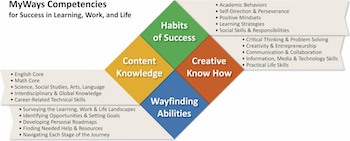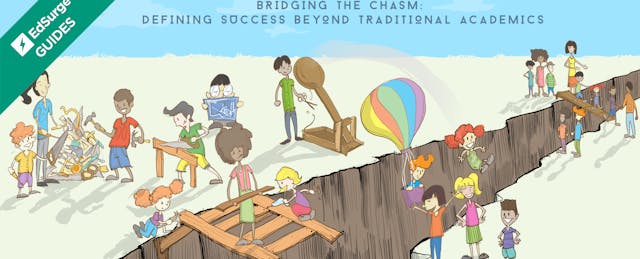Defining student success was once much simpler. High scores on a report card or standardized tests gave students, families and teachers reason to celebrate. But numbers and letters no longer adequately signal how well learners are prepared for life after high school.
In response, some schools are embracing broader definitions of success, venturing beyond traditional academic measures to focus on skills, habits, competencies and personality traits that will enable students to thrive in their future lives.
But breaking tradition isn’t easy. Redefining student success requires schools to change what they measure and how they measure it—a complex task that morphs curriculum, assessment, professional learning and ultimately, school culture. Communicating the importance of these values to students, teachers, families and funders also poses challenges. As long as postsecondary schools continue to weigh academic achievement heavily, they will feel pressure to produce high grades—sometimes at the expense of these newly emerging measures.
To complicate things further, many of the skills included in these new definitions of success are difficult to teach and even harder to measure. Gauging growth in self-direction or problem solving isn’t as cut and dry as assessing content knowledge. In many cases, different assessment tools are needed; if you redefine “success” yet continue to use the same yardstick to measure progress, will anything actually change?
There are a number of education organizations building twenty-first century learning resources to help schools as they consider making some of these changes. Frameworks such as Deeper Learning Competencies from the Hewlett Foundation, Framework for 21st Century Learning from P21 and Teaching Adolescents to Become Learners from University of Chicago’s Consortium on School Research, highlight and organize competencies that will prepare learners for today’s college and career landscape.
The MyWays project developed by Next Generation Learning Challenges (NGLC) provides a student success framework that is inspired by more than 25 major frameworks and dozens of other resources. It is designed to help school communities build a common language to use as they discuss the competencies that today’s learners need to thrive after high school. The project further seeks to help school leaders redesign learning and assessment models to align with their new vision.
Naming and defining these competencies is the first step. Next, school leaders need examples of how other schools are already integrating them into teaching and learning.
This guide includes an inside look at the MyWays framework, along with a collection of stories highlighting schools that are broadening their definitions of success and shifting their models to better prepare students for the journey after high school.
This guide is made publicly available with support from Next Generation Learning Challenges, an initiative of EDUCAUSE that enables educators who are reimagining public education.
—Marisa Kaplan, Guide Editor
MyWays Framework and Alignment Chart
The MyWays framework outlines 20 competencies that contribute to success after high school. The competencies are grouped into four domains: Content Knowledge, Creative Know-How, Habits of Success and Wayfinding Abilities. Here is the framework and a matrix showing how MyWays aligns with other selected frameworks.
View full-sized image View full-sized image


Redefining Student Success: Stories From the Field
Learn how the MyWays project and framework can help school leaders implement change from Andy Calkins, director of NGLC. Then, see what the process of redefining success looks like in action through five stories that give you a glimpse inside the transition, the outcomes gained and the obstacles faced.
These five schools have either participated in NGLC’s Breakthrough Schools initiative or Assessment for Learning Project and are using MyWays to push their thinking as they shift their models to include a broader set of competencies geared toward future success.
Gauging Growth in Non-Academic Skills
How a school defines success drives major decisions including which competencies are prioritized in the learning model, and how student progress is gauged for each; but some are simpler to measure than others. These four stories shed light on the complexities of evaluating growth in non-academic skills, and provide insights into new measurement approaches.


